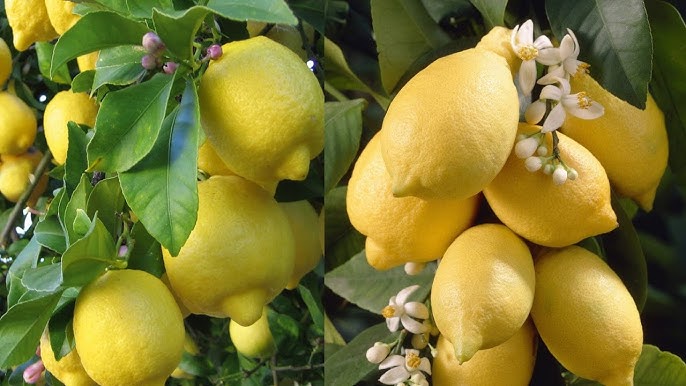Lemon trees are known for their beautiful blossoms and tangy fruit, but sometimes, getting them to produce throughout the year can be a challenge. A powerful technique used by many gardeners to boost lemon fruit production is the process of drying out or water deprivation, commonly referred to as “watering stress.” If you want to ensure that your lemon trees bear fruit consistently, here’s how to use this method effectively.
Understanding the Drying Process: How It Works for Lemons
Lemon trees, like many other fruit-bearing plants, respond to stress by entering a rejuvenation phase. By withholding water for a brief period, the trees shed old blossoms and prepare for new growth. This process doesn’t harm the tree but stimulates it to produce fresh flowers, which will quickly turn into fruit. It’s a tried and tested way to induce faster and higher-quality fruit production. Let’s break this down into easy-to-follow steps:
1. The Drying Phase (March – April)
The first and most crucial phase in the process is the water deprivation period. During this time, you will stop watering your lemon tree completely. This might sound counterintuitive, but it’s actually vital for the tree’s productivity.
- How long should the drying period last?
You should aim to withhold water from the tree for about one to two months. The exact duration depends on the climate and the health of the tree, but one month is typically sufficient in most regions. - What happens during the drying phase?
As the tree goes without water, it will shed older flowers and any weak or damaged growth. This forces the tree into a natural survival mode, preparing it for the next stage of growth. It’s during this phase that your tree will start focusing energy on producing new buds and blossoms. - When to start the drying phase?
Timing is essential. Aim to start the process in early spring (around March to April). This ensures that your tree has the right environmental conditions to recover and bloom again.
2. Intensive Watering and Fertilization (May)
After the drying phase, it’s time to rehydrate your tree and give it a boost of nutrients. This will jump-start the tree’s blooming process, helping it to produce fresh flowers that will develop into fruit.
- Watering
Once the drying period is over, give your lemon tree a deep watering. This isn’t just a light sprinkle; it’s important to thoroughly soak the soil to encourage the roots to absorb moisture and kick-start growth. - Fertilizing with Organic Compost
Fertilizing your tree during this phase is crucial. Use organic compost or well-balanced fertilizer to provide the necessary nutrients for new growth. Organic fertilizers are highly beneficial as they promote long-term soil health and improve the overall vigor of your lemon tree. - Why Organic Fertilizer?
Organic fertilizers release nutrients slowly over time, giving your tree steady nourishment as it enters its next blooming phase. They also help maintain the soil’s fertility and structure, ensuring your tree continues to thrive.
3. Rapid Fruit Development

Once the new blossoms start appearing, you’ll notice how quickly they turn into fruit. The combination of rehydration and fertilization causes the flowers to quickly develop into fruit, meaning you’ll have a crop ready much sooner than expected.
- Why the quick transformation?
The stress from the drying period, combined with the nurturing watering and fertilization, speeds up the tree’s reproductive cycle. The blossoms don’t have to fight for survival anymore and can rapidly develop into lemons.
4. Tips for Success
While this technique is powerful, it’s essential to follow a few key tips to ensure the best results:
- Timing is Everything
Monitor your tree carefully and adjust the drying period depending on how your lemon tree is responding. Starting the drying phase too late or too early can result in missed blooming cycles or damage to the tree. - Quality of Water
Once you begin watering again, make sure to use clean, fresh water. Avoid using salty or polluted water, as this can damage your tree and inhibit fruit production. - Proper Fertilization
Choose an organic fertilizer that is rich in potassium, magnesium, and phosphorus, as these elements are essential for fruit production. Regularly check the tree’s growth and adjust the fertilization plan as needed. - Inspect Regularly for Pests
During these phases, your tree might become more vulnerable to pests. Keep an eye out for any signs of infestation or disease. Healthy trees are less susceptible to pests, but vigilance is always important.
5. Final Thoughts: Patience Pays Off
Patience is key when it comes to gardening, and this method is no different. While you might not see results overnight, by following the drying and watering process carefully, you can significantly improve the fruit production of your lemon trees. Within a few months, you will likely notice an increase in fruit yield and the quality of the lemons, especially if you continue to monitor and care for the tree.
Remember, this method can be repeated annually, and with every cycle, your lemon tree will grow stronger, healthier, and more fruitful. Your garden will soon be overflowing with fresh, homegrown lemons that can be used for everything from cooking to homemade lemonade.
With dedication and proper care, you’ll be enjoying a year-round supply of lemons in no time!
Happy gardening! 🌿🍋


buy amoxil online – amoxil pills purchase amoxil sale
purchase fluconazole online cheap – site order forcan online
lexapro 20mg pill – https://escitapro.com/ order lexapro 10mg generic
buy cheap cenforce – https://cenforcers.com/# cenforce 100mg drug
cialis with out a prescription – https://ciltadgn.com/ tadalafil online canadian pharmacy
no presciption cialis – cialis and dapoxetime tabs in usa cialis generic best price that accepts mastercard
viagra sale new zealand – sildenafil 50 mg precio generic viagra 100mg
ranitidine 300mg pill – ranitidine 150mg pill where can i buy zantac
The reconditeness in this piece is exceptional. https://buyfastonl.com/isotretinoin.html
This is the stripe of content I get high on reading. https://gnolvade.com/es/doxicicline-comprar-online/
The thoroughness in this break down is noteworthy. https://prohnrg.com/product/loratadine-10-mg-tablets/
Proof blog you possess here.. It’s severely to assign high calibre article like yours these days. I truly recognize individuals like you! Go through care!! https://ursxdol.com/propecia-tablets-online/
This is the kind of content I take advantage of reading. online
Thanks an eye to sharing. It’s outstrip quality. https://ondactone.com/simvastatin/
This website absolutely has all of the low-down and facts I needed about this case and didn’t positive who to ask.
https://doxycyclinege.com/pro/spironolactone/
Thanks an eye to sharing. It’s top quality. http://www.underworldralinwood.ca/forums/member.php?action=profile&uid=488144
purchase forxiga – https://janozin.com/ forxiga 10mg over the counter
buy xenical cheap – buy xenical generic purchase orlistat without prescription
More posts like this would add up to the online elbow-room more useful. https://www.forum-joyingauto.com/member.php?action=profile&uid=49492
You can shelter yourself and your dearest close being alert when buying pharmaceutical online. Some pharmaceutics websites control legally and provide convenience, secretiveness, rate savings and safeguards as a replacement for purchasing medicines. buy in TerbinaPharmacy https://terbinafines.com/product/inderal.html inderal
This is the kind of advise I unearth helpful. TerbinaPharmacy
More posts like this would persuade the online space more useful.
https://t.me/s/iGaming_live/4868